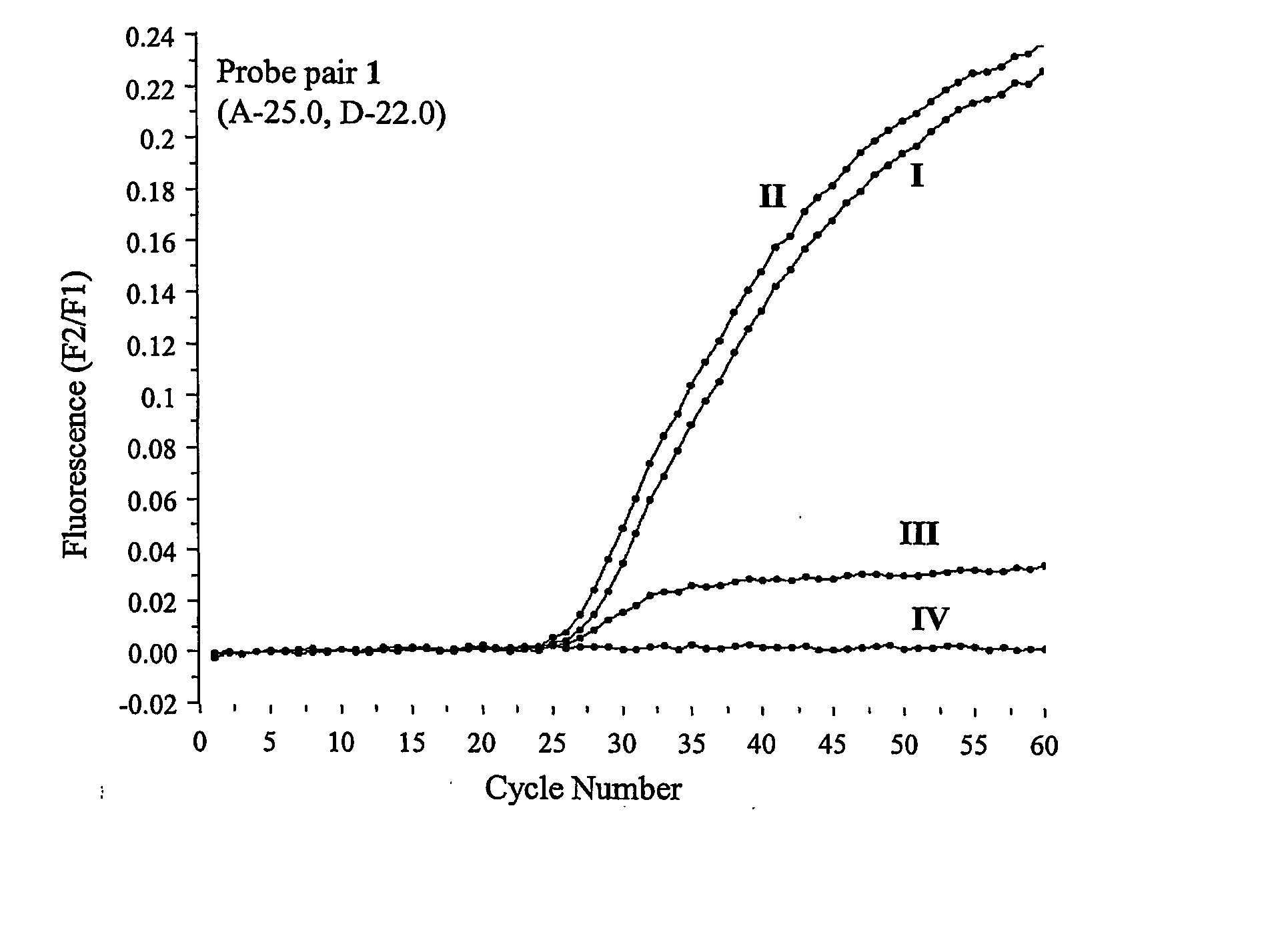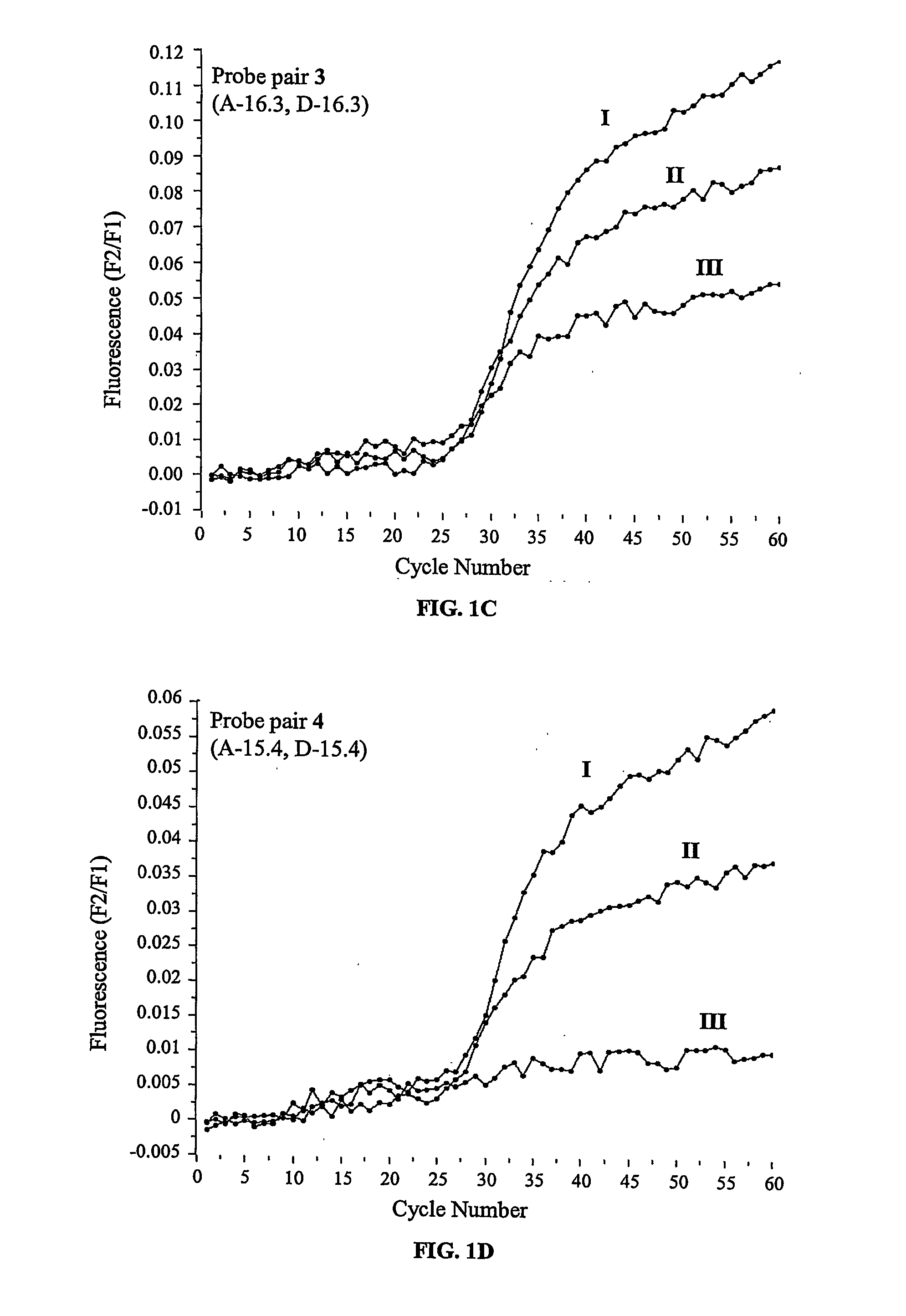Fluorogenic Nucleic Acid Probes Including Lna for Methods to Detect and/or Quantify Nucleic Acid Analytes
a nucleic acid analyte and fluorogenic technology, applied in the field of molecular biology, can solve the problems of increased detector fluorescence, false positives, and prone to contamination, and achieve the effect of quenching the detector fluorescence, increasing the fluorescence of the detector dye, and not being quenched
- Summary
- Abstract
- Description
- Claims
- Application Information
AI Technical Summary
Benefits of technology
Problems solved by technology
Method used
Image
Examples
example 1
General Procedure for the Preparation of the Labelled Oligo Probes
[0087] Oligonucleotide primers and probes were synthesized on a UFPS-24 synthesizer (Proligo LLC, Boulder, Colo., USA) using standard phosphoramidite chemistry, as known in the art. The 3′-fluorescein-labelled probes were synthesized using a fluorescein labelled CPG (Roche Diagnostics, Indianapolis, Ind., USA). The resulting labelled probes were purified by reverse phase high pressure liquid chromatography (HPLC) (Waters Symmetry Column, 5 μm, 3.9×150 mm, C18). The purities of these probes were determined by analytical reversed phase HPLC with monitoring at wavelengths of 260 nm and 495 nm.
[0088] The LC Red 640 labelled probes were synthesized using a phosphate-on CPG (Proligo LLC, Boulder, Colo., USA). Amino functionalization of the 5′-terminus was achieved by adding an amino modifying amidite with a C6 linker (Glen Research, Sterling, Va., USA) in the last synthetic cycle. After the deprotection and desalting step...
example 2
General Procedure for Performing Real-Time PCR Experiments with Hybridization Probe Pairs
[0089] The experiments were performed on a LightCycler™ thermal cycler (Roche Diagnostics, Indianapolis, Ind., USA). The PCR reactions were set up in a total volume of 25 μL with each tube containing standard PCR buffer (10×, 2.5 μL), MgCl2 (4 mM), the deoxynucleotide triphosphates dATP, dGTP, dCTP and dTTP (200 μM each), the forward and reverse primers 5′-agg aag atg tgc ctt tca-3′ (SEQ ID NO:1) and 5′-aaa tgc ttg cta gac caa t-3′ (SEQ ID NO:2) (500 nM each), template DNA (10 ng), FastStart™ Taq DNA-Polymerase (1 unit, Roche Diagnostics, Indianapolis, Ind., USA), BSA (0.5 mg / mL), the probe derivatized with fluorescein (200 nM) and the probe derivatized with LC Red 640 (400 nM). The reactions were initiated at 95° C. for 7 minutes, followed by 60 cycles of denaturation at 95° C. for 10 seconds, annealing at 72° C. for 10 seconds and elongation at 72° C. for 15 seconds. The fluorescence intensit...
example 3
General Procedure for Measuring Melting Curves of Hybridization Probe Pairs
[0090] Following real time PCR experiments as performed according to Example 2 the samples, still located in the LightCycler™ thermal cycler, were subjected to the following temperature profile: 95° C. for 30 seconds, 40° C. for 30 seconds and heating from 40 to 75° C. at a rate of 0.1° C. per second. The fluorescence intensities were recorded as a function of temperature in relation to the background fluorescence of a sample that was processed as specified above except that no template was added.
PUM
| Property | Measurement | Unit |
|---|---|---|
| wavelengths | aaaaa | aaaaa |
| wavelength | aaaaa | aaaaa |
| Tm | aaaaa | aaaaa |
Abstract
Description
Claims
Application Information
 Login to View More
Login to View More - R&D
- Intellectual Property
- Life Sciences
- Materials
- Tech Scout
- Unparalleled Data Quality
- Higher Quality Content
- 60% Fewer Hallucinations
Browse by: Latest US Patents, China's latest patents, Technical Efficacy Thesaurus, Application Domain, Technology Topic, Popular Technical Reports.
© 2025 PatSnap. All rights reserved.Legal|Privacy policy|Modern Slavery Act Transparency Statement|Sitemap|About US| Contact US: help@patsnap.com



